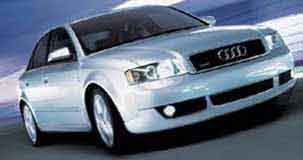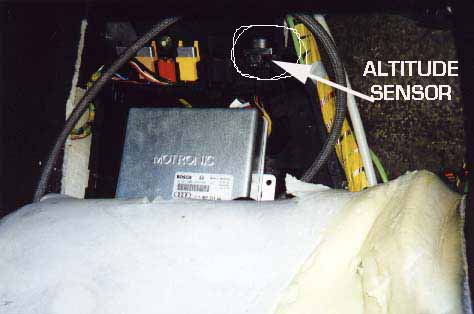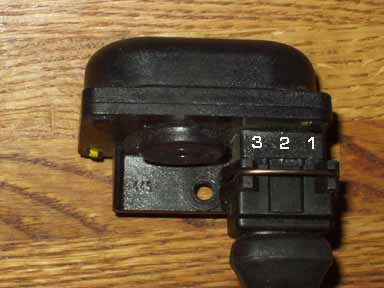

|
20V Motronic ECU System, Technical Tips, 1991 200TQ and 1992-95 S4/S6 with 20V Engine: Altitude Sensor The altitude sensor monitors the barometric pressure of the air around you to allow the ECU to adjust the boost pressure as the vehicle is driven at higher altitudes. This adjustment is necessary to prevent over spinning the turbo impeller blades. NOTE: If the sensor fails, the ECU will assume an altitude of 13,124 feet and the boost pressure is reduced to its minimum value. [1] On the 1991 200TQ 20V, the sensor is located under the lower left kick panel below the dash and below the A pillar. On the 1992-95 S4/S6, the altitude sensor is located just above to the right of the ECU, behind the passenger foot well carpet area. The carpet may need to be sliced on the left side. The plastic cover over the ECU needs to be removed. Details on accessing the S4/S6 ECU can be found here.  The Altitude Sensor terminal #2 is supplied +5V from the ECU, and the sensor gets the ground signal on terminal #3. You can use a Digital Multi-Meter (DMM) to verify you have a good 5.0V supply voltage from terminal 2 and 3. If not, check the wiring between the ECU and the altitude sensor. The altitude sensor output voltage is on terminal #1. When you connect a voltmeter positive connection to terminal #1 and the negative connection to terminal #3 (ground), the voltage measured will be "approximately" 4.0 to 4.1 volts when the vehicle is at 600-800 foot elevation. As you go up in elevation and the air pressure is reduced, the voltage output of the sensor will be reduced and should drop below 4.0 volts. See photo below for the terminal location. 
Return to 20V ECU System information index References: [1] Audi of America, Technical service training publication: "The New 20V Turbo Engine for the Audi 200 Quattro-publication All rights reserved. Copyright © SJM Autotechnik™ , all rights reserved Return to Troubleshooting Tips page. Return to SJM Autotechnik™ main page. |
| About Us Privacy Policy Terms of Use Links Customer Service Safety Information Home |